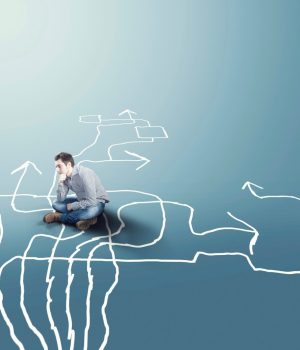My reading obsession started with the book, The Ugly Duckling.
Spoiler alert: An ugly duckling matures into a beautiful swan.
But it really began to take off with the Harry Potter series. Oh man, I love those.
I just read.
And read.
I read everything, but the content I explored was extremely random. From Russian novels to cheesy literature, all the way to self-development books.
I used to spend my summers reading while my friends were out getting drunk. And then, something else got added up to the mix: speed reading.
Woah man.
At the age of 15, I was reading up to 8 books a month. I was reading in class, at home or whilst traveling. Then I started studying at university, and speed reading started causing me problems. Once technical literature came along, I realized that dense information could not be consumed in the same way I could learn about “Why Snape killed Dumbledore.”
Speed reading a book on Neuropsychology would drastically reduce my reading comprehension and retention. So I decided to pause speed reading and ask myself a question: if speed reading is one side of the coin, what is the another side of the coin?
Since I was studying Adult Education and Lifelong learning, I decided to start an experiment. In a typical experimental fashion, research was the first phase.
This was followed by asking myself a fundamental question: if I’ve already mastered how to become a faster reader, how can I become a better reader?
What I hypothesized is the following:
Comprehensive Reading + Speed Reading = The most EFFICIENT reading experience
Keep in mind that implementing these things can be a bit of a longer process. But once it becomes a habit, you will see how it affects you and your growth and how you can actually gain full control over the information you consume.
Today, we are in the age of “information overflow”, where we are bombarded with tons of information that don’t benefit us at all.
Therefore, we must learn how to control and acquire information as efficiently as possible. This will benefit our goals, both personally and professionally. If you could control how efficiently you acquired knowledge, imagine how much more you could accomplish and achieve.
So without any further ado.
Here’s how to become a better reader
There are several things you should do before, during, and after reading any book you want that will drastically improve your reading efficiency.
1. Set a goal
As always, you start with the question: Why am I engaging in this activity? Define whether or not you are reading something for personal pleasure or professional gain.
2. Determine “The One Thing”
Once you define whether it is personal or professional, the next thing is to define what is “The One Thing” you are looking for.
Let me explain.
If you read a book that’s 300 pages and only get one useful idea from it, consider this to be a success.
In order to make this even more efficient, ask yourself this question before you even start: What am I looking to learn (=get) out of this book?
3. Don’t forget the Table of Contents
Table of contents is one of those things everyone skips and goes straight for the content. This tends to be a big mistake.
When you go through the table of contents, your brain maps out what will be covered in the book, and gives it direction. Now your mind is already prepared once you’ve reached a specific topic. Plus, you can also make conclusions on what’s to come.
4. Skim
This strongly relates to the previous step. Skimming should be used for two reasons: once you finish with the Table of Contents, go ahead and flip through your book. Focus on main titles, subtitles, and anything that’s bolded or italicized. This will help you get more out of the book.
Not all books are made fun, entertaining and useful. That’s why you shouldn’t put yourself through the struggle of reading every piece of dull text, but when reading give yourself the freedom to skim parts that are just “FLUFF” (shhh…I do it too)!
A rule in writing is that the first and the final chapter often reveal main ideas. Similarly, the first and the last paragraph of a chapter often give you the main idea of the chapter.
To bring this down to an even more granular level, the first and the last sentence of a paragraph often give you idea of what that paragraph will be about, everything else is just a description.
The actual reading
This is where speed reading comes along, and the things you will learn below will help you with this step. At this point, the steps above, have already helped you with your retention and comprehension.
Commit to note taking
Once of the most crucial parts of efficient reading. And one of the most underestimated ones. Finding a way to take notes that would suit your learning style helps you retain much more information.
I believe this can be done in 2 distinct ways by preparing:
- Written notes (digital or notepad)
- Audio notes (with an app or digital recorder).
Review your notes
When I first began to work on my reading skills, the biggest mistake I would make is taking a bunch of notes and never going back to review them. So, learn from my mistake:
Review. Your. Notes.
Establish a habit that once a week, you go back and take a look at the notes you took. See what’s useful and what can be used for your goals. For things that are not useful, delete.
Make decluttering part of your ritual.
Now that the reading comprehension skill is mastered, I am now moving to speed reading.
Here I researched the techniques and best case practices.
How to become a speed reader
Let’s see how fast you can read now
Before we get into the actual steps of speed reading, let’s measure how fast you read now. Then, you can establish a baseline and determine improvement from there.
To determine your current reading speed, find a book on which you will practice. It should be a book that is “a medium” level difficulty reading.
Then, follow this simple 5-step process.
Step 1: Take the book and count the number of words in 5 lines. Divide the number of words by 5, and you have your average number of words-per-line.
Example: 70 words/5 lines = 14 words per line.
Step 2: count the number of text lines on 5 pages and divide by 5 to arrive at the average number of lines per page.
Step 3: Multiply this by an average number of words per line, and now you have your average number of words per page.
Example: 160 lines/5 pages = 32 lines per page x 14 words per line = 448 words per page
Step 4: Mark your first line and read with a timer for 1 minute at a normal speed where you are actively comprehending the material.
Step 5: After one minute, multiply the number of lines by your average words-per-line to determine your current words-per-minute (wpm) rate.
Now you know your reading speed!
Let’s go on to the actual speed reading
Speed Reading includes two important aspects:
- Things that you should start doing
- Things that you should stop doing.
 Use a pointer
Use a pointer
Pointer = a pen, a finger or a palm of your hand.
How this works: your mind tends to skip from word to word, and each jump reduces your reading speed. When you use a pointer, you guide your eyes (and your mind), so it makes a smoother transition from word to word.
The pointer is basically taking your eyes by the hand, and walking them down the page. This will actually save your more time in the long run, too.
Reduce time spent per line
On average, it takes up to 1 ½ seconds to read one line.
This is a way too long.
What you should do is to slowly start reducing the amount of time you are spending per line until you’ve reached ½ a second per line.
Your comprehension won’t be influenced.
Utilize peripheral vision
It is naive to assume that we need to look at an entire page in order to see what’s on it.
Our peripheral vision is far more developed than that. That’s why you should slowly start reducing the amount of words you look at per line.
Right now you are most likely reading from the beginning of the line to the end. Worry not, this is normal.
Your approach should be the following:
Focus on the second word of the line (you automatically register the first) and end your focus before the end of the line.
Example:
“If you are reading this sentence right now, you should have started on the bolded words.”
Practice until you become proficient. See what I did there?
Next, move on to the 3rd word of the line, until you can read only the center of the page, while comprehending the text.
Things that you should stop doing
 Regressing and back-skipping
Regressing and back-skipping
Have you ever read a full page, and just before moving to the next one, you thought you weren’t paying attention so you went back?
This process is called back-skipping. The thing is: you did read it, and your mind did register it. So whenever you go back, you lose time.
So you need to train yourself to continue reading without looking back. And stop paying attention to the voice which says, “man, but if you continue, you’ll miss something important!”
Eventually, you will train yourself and your brain to pay more attention and reduce room for mistakes.
Sub-vocalizing
When we were kids, we were thought to read one word at the time and to read it out loud. Problem is, even though we now read to ourselves, the voice remains.
The idea: Don’t set the intention to eliminate it, as this often makes eliminating it even more difficult. Rather, focus on other techniques we’ve already covered. Begin to place more of your attention on the visual, instead of the auditory.
Once you begin doing this, the voice will slowly begin to fade.
After a while, your brain will acquire everything that’s important on the page.
Putting it all together
Once you have applied these techniques that I’ve listed, you should actively practice and calculate your new reading speed (WPM).
Comprehensive Reading and Speed Reading are two things that go hand in hand, but they should be adapted to the type of the content you are reading and the purpose behind you reading it.
Meaning: if you are reading a novel for personal pleasure, speed reading isn’t necessary, because you probably want to immerse yourself in the story.
But, in case you are reading something to acquire information, then the instructions above will give you the fastest results.
Being able to control how actively and efficiently you acquire new skills will rapidly boost both your personal and professional growth.
This article was originally published on Zero To Skill.
For more learning and productivity tips, check and entrepreneurship sections and subscribe to our weekly newsletters.




![Best startup accelerator programs in Europe [2025 Edition] alphagamma best startup accelerator programs in europe entrepreneurship](https://agcdn-1d97e.kxcdn.com/wp-content/uploads/2023/11/alphagamma-best-startup-accelerator-programs-in-europe-entrepreneurship-300x350.jpg)


